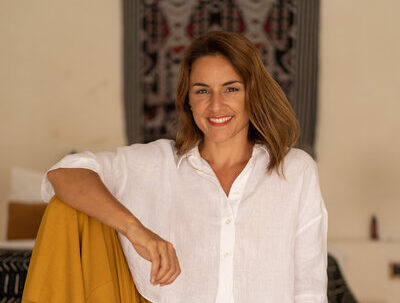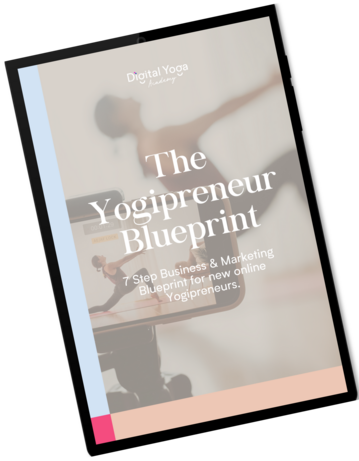Ok, I know that building your own yoga website can seem so overwhelming that you just don’t know where to start.
There are so many options when it comes to building your yoga website. WordPress, Squarespace, Wix are just a few of the platforms available to you, each with their pros and cons.
For some of us, this can be off-putting enough when you don’t know where is best to start with building your yoga website. Especially if you aren’t naturally techy or a ‘coder’.
But don’t you worry, I am here to guide you and speak in a non-techy way about where to start. And that’s here – with the misconceptions, myths or beliefs you may have about setting up a yoga website.
Let’s break through these myths so that you can get in the right mindset. And believe that a yoga website is an essential part of a successful yoga business…because it really is!
Myth #1: “Yoga websites cost thousands to build”
They only cost a fortune if you pay someone a fortune to do it for you.
If you hire a freelancer to design a basic yoga website, it will set you back around $2000 and your site would most likely be built using WordPress or Squarespace.
This rises rapidly depending on the complexity and scale of your website. Large websites can cost well over $10,000 if you want to include top quality, original design and industry-leading technology.
You then have ongoing costs for updates and maintenance if you’re relying on someone else to maintain your site for you.
If your teaching schedule changes or you have a new workshop that you want to promote, you’re relying on someone else to make those changes for you. And of course, this adds to the cost every time.
So what’s the alternative?
Well, you don’t need to resign yourself to the fact that you’re going to have to wait until you can save your pennies for a professional website.
You can build it yourself!
It only costs around $15 a month for hosting and a WordPress theme and you really only need a few basic building blocks to get started.
Myth #2: “Why WordPress? All website platforms are the same aren’t they?”
One of the reasons I love WordPress is that it has loads of brilliant templates or ‘themes’ to give your yoga website a designed look.
Not sure what a theme is? Let’s break it down.
The hosting provider is the land where you’re building your website. WordPress is the framework (or the building) that your website is built on top of. The theme is the look and feel of that framework that you use to design your website.
Website themes help to keep the look of your brand consistent across your website without hiring a designer. You can easily and quickly change the theme template, images and words at the click of a button. So again you don’t have to hire someone to do it for you.
If you’re completely new to WordPress, I recommend using the Make theme by the Theme Foundry. It’s super easy for first-time learners and to get a basic website up and running as quickly as possible.
As your yoga brand gets bigger and better (as that’s the plan right?) you can scale up your website from a low-cost theme to something more advanced as WordPress is so flexible.
Once you have your content together and have got to grips with WordPress, an option is to move onto a premium paid theme to give your yoga website an even more professional look.
With WordPress the options are endless!

Myth #3: “But don’t I have to learn to code before creating a website myself?”
Nope!
Trust me when I say it is totally possible to build your yoga website in a weekend!
Using WordPress to get started means that everything is there for you already. All you need to do is decide on which theme you like the best and start building.
My coding knowledge is very limited and I’ve built many websites using WordPress without having any coding skills.
Most themes have a customer service team who can help you with any queries such as if you are trying to achieve something specifically that is outside of the realms of the themes set up.
More often than not they will provide you with a piece of custom code and tell you where to place it. Or they might even head into the backend and do it for you!
So I really encourage you to break through this myth as it comes up a lot. And it really shouldn’t be something that holds you back.
Myth #4: “I’ve built my yoga website now so why aren’t I getting zillions of hits a day?”
Great!
Well done on building your first website. Now you need to lead your students to it.
Make sure that all of your social media accounts have your website address on them (i.e. in the bio of your Instagram account). And that you’re sharing links to your website on a regular basis. You should think about the hooks and the reasons why you could share your website
So this could be if you’re writing and creating blog posts. You can share the links to your blog posts in yoga Facebook groups. That is a great way to send new people to visit your website to read your blog.
And if you’re not blogging, check out the reasons why you should be here:
7 reasons why yoga teachers should start blogging
You could consider guest blogging where your content is published on someone else’s website with a link back to your own website. Ideally, the other blog has an audience reach bigger than your own but that closely matches your ideal student.
At the end of your yoga classes, you should mention your website and anything new for people to check out. Perhaps new events or to see where else you are teaching yoga that week and for them to book online.
Any flyers/ business cards you create also need to carry your site details on there.

Myth #5: “But I have my social media accounts to manage. Isn’t that enough?”
I’m afraid not.
Your social media accounts are just one (of many) ways to connect with your fellow yogis and your students.
We do not have any control over the social media platforms we use. This means that we don’t actually own our followers or accounts in the same way that we own our yoga website.
We have complete control over how our own website looks, how people can interact with it and what we put on there.
Facebook or Instagram could change the way we use them as businesses tomorrow. They can change algorithms so that it becomes harder to reach the audiences that we have grown on our pages.
This is something that Facebook has already done as only a very small percentage of your followers will see your content. And so Facebook ads start to play a role in reaching your Facebook audience.
Instagram is following suit – of course, they’re owned by Facebook so it was only time. – and we’ve already seen the introduction of business profiles on Instagram. So that’s a clear indication that changes for businesses using Instagram are on the way.
At least with your yoga website you know that everything you put up there can be seen by everyone who clicks onto it.
Myth #6: “I’ll ask my friend who is good with websites to help!”
They can but it won’t benefit you long term.
And honestly, nowadays the tools and templates that software such as WordPress provide mean that you don’t have to be techy or ‘good with computers’ to build a yoga website!
I honestly believe that with a little effort ANYONE can create a beautiful website. I’ve helped lots of lovely yoga teachers create their own website and I can help you through it too!
If someone else builds your yoga website for you then you won’t be able to update it without their help. That is because you didn’t spend the time learning the ins and outs of your website.
Imagine being away hosting a yoga retreat and having to wait to get home to add a video of the retreat so you can build on the momentum and buzz and start selling your next one. This could lead to loss of business if your students can’t see when your next classes, workshops and retreats are!
Once you have learnt the basics you will see that it is super easy to update your yoga website from anywhere in the world.
How empowering and fantastic is that?
So what are you waiting for? You can start building your website today by starting on your content and working out the pages you need for your site. That way, when you come to build your website, you’ll have the content ready to drop into the pages you’ve built.
Why do I need a website for my yoga business?
A website is essential for your yoga business as it provides a professional online presence, helps potential clients find you easily, and allows you to showcase your classes, services, and credentials. It’s also a great platform for sharing your knowledge through blog posts, videos, and other content.
What information should I include on my yoga website?
Your yoga website should include information about your credentials, class offerings, pricing, location, and contact details. You may also want to add a blog, testimonials, videos, and an online booking system. This blog post provides a comprehensive guide on what to include to create an effective yoga website.
How can I make my yoga website stand out from the competition?
To make your yoga website stand out, focus on showcasing your unique teaching style, sharing authentic content, and creating a visually appealing design. Optimize your site for search engines, engage with your audience through your blog and social media, and offer valuable resources to attract and retain visitors. This blog post offers additional tips and strategies for creating a standout yoga website.







